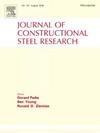Equivalent sway imperfections for use in structural steel design by GNIA
IF 4
2区 工程技术
Q1 CONSTRUCTION & BUILDING TECHNOLOGY
引用次数: 0
Abstract
Typically, sway imperfections refer to the out-of-plumbness of structural frames and are a key modelling requirement in design by geometrically nonlinear analyses with imperfections (GNIA). Equivalent geometric imperfections, accounting for the combined influence of initial geometric imperfections, the spread of plasticity and residual stresses, are used for modelling convenience. In EN 1993-1-1, the equivalent member bow imperfection amplitudes for use in design by GNIA are dependent on the imperfection factor (i.e. the assigned buckling curve), the material parameter , the axis of buckling and the type of cross-section resistance check to be performed. By contrast, for equivalent sway imperfections , two constant values – one for elastic and one for plastic cross-section checks – are provided. The dependency of on the imperfection factor and the material parameter rightly reflects the varying influence of residual stresses and material grade on member buckling. However, sway buckling is also influenced by residual stresses and material grade; the suitability of the current EN 1993-1-1 provisions for is therefore questioned. In the present paper, new equivalent sway imperfections suitable for use in the design of steel and stainless steel structures by GNIA are proposed. The new proposals are shown to be able to provide improved capacity predictions, particularly for stainless steel structures, and are recommended for inclusion into future revisions of Eurocode 3.
GNIA 用于钢结构设计的等效摇摆缺陷
通常情况下,摇摆不平顺指的是结构框架的不平顺,是通过不平顺几何非线性分析(GNIA)进行设计的关键建模要求。等效几何缺陷考虑了初始几何缺陷、塑性扩散和残余应力的综合影响,便于建模。在 EN 1993-1-1 中,用于 GNIA e0,GNIA 设计的等效构件弯曲不平顺振幅取决于不平顺系数 α(即指定的屈曲曲线)、材料参数 ε、屈曲轴线以及要进行的截面抗力检查类型。相比之下,对于等效摇摆不完善度 j0,GNIA,提供了两个常数值,一个用于弹性截面检查,另一个用于塑性截面检查。e0,GNIA 与不完善系数 α 和材料参数 ε 的关系正确地反映了残余应力和材料等级对构件屈曲的不同影响。然而,摇摆屈曲也会受到残余应力和材料等级的影响;因此,现行 EN 1993-1-1 中关于 ϕ0,GNIA 的规定是否适用受到质疑。本文提出了适用于采用 GNIA ϕ0,GNIA 进行钢结构和不锈钢结构设计的新的等效摇摆缺陷。新建议可提供更好的承载能力预测,尤其是对不锈钢结构而言,建议将其纳入未来的 Eurocode 3 修订版中。
本文章由计算机程序翻译,如有差异,请以英文原文为准。
求助全文
约1分钟内获得全文
求助全文
来源期刊

Journal of Constructional Steel Research
工程技术-工程:土木
CiteScore
7.90
自引率
19.50%
发文量
550
审稿时长
46 days
期刊介绍:
The Journal of Constructional Steel Research provides an international forum for the presentation and discussion of the latest developments in structural steel research and their applications. It is aimed not only at researchers but also at those likely to be most affected by research results, i.e. designers and fabricators. Original papers of a high standard dealing with all aspects of steel research including theoretical and experimental research on elements, assemblages, connection and material properties are considered for publication.
 求助内容:
求助内容: 应助结果提醒方式:
应助结果提醒方式:


